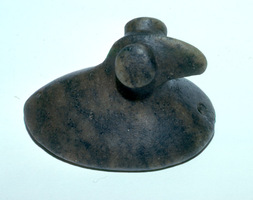 | Back to e-WV
| Back to e-WV
 The West Virginia Encyclopedia
The West Virginia Encyclopedia
 | Back to e-WV
| Back to e-WV
 The West Virginia Encyclopedia
The West Virginia Encyclopedia

The prehistoric Adena culture developed with the beginnings of horticulture about 2,500 years ago within the Ohio River Valley and along major tributaries such as the Kanawha, Scioto, and Kentucky rivers. This was the time known to archeologists as the Early Woodland Period, and the Adena culture continued to the end of the Early Woodland, about 200 BC. The Adena were mound builders, best known for the burial mounds that still stand today at places in West Virginia and the neighboring region. The Adena culture was named for the Adena Estate near Chilicothe, Ohio, the location of a major Adena-era mound.
The Adena were among the most important prehistoric peoples to occupy present West Virginia. The word refers to a culture rather than to a particular ethnic group. The archeological evidence suggests that many language or ethnic groups made the artifacts that today we recognize as part of the widespread Adena culture. The Adena were characterized by widespread trade and the use of exotic artifacts from distant places in complex burial rituals involving mound building and geometric earthworks. People of the Adena culture left their enduring mark on the region with these works. Major examples survive today at Moundsville, South Charleston, and other places in West Virginia.
Evidence for long-distance trading among people at this early period comes from the excavation of the many burial mounds that dot the valleys and river confluences of the Ohio River watershed. Navigable rivers connected isolated villages into trade networks that moved artifacts from their sources in the Gulf Coast (marine shell), Upper Midwest (copper), and Appalachian (mica, ceramics) regions to communities throughout present southwestern West Virginia, northern Kentucky, and southern Ohio. Items such as stone pipes, copper gorgets, bracelets, finger rings, and pieces of mica fashioned into headdress or hair ornaments have been recovered throughout the area.
Only certain men and women were buried in the large log-lined tombs characteristic of Adena mounds. These log tombs were covered with earth to create a crypt within the earthen mound. New interments were either added to existing mounds, or new mounds were started nearby to create clusters of mounds. Such clusters were documented in the Charleston region more than 150 years ago. Most people, however, were cremated, and their ashes interred in the mound or elsewhere.
Other than mortuary mounds, Adena people also created large circular, rectangular, or hexagonal earthworks by digging ditches and using the excavated soil to build a surrounding berm of earth. It is known that these earthworks were not defensive sites, but the activities that occurred within them are largely undocumented since so few contained artifacts of any kind. Their cleaned interiors suggest a ritual use for such places, perhaps as ceremonial dance grounds or meeting places where villagers from isolated settlements came together.
Recent excavations indicate that Adena communities survived by hunting and gathering, supplemented by growing domesticated plants such as goosefoot, maygrass, and sunflower. Typically, settlements consisted of one or two circular houses, about 30 feet to 50 feet in diameter, with a central fireplace, and storage pits. Associated refuse indicates a short period of occupation, perhaps only a couple of years, before a settlement was abandoned and a new one established. Interestingly, few settlements contain any of the kinds of exotic artifacts found at Adena burial sites, suggesting that a high value was placed on these traded items, their significant role in ritual life, and their separation from everyday activities.
These early mound builders were the ancestors of the Hopewell Indians who also developed extensive exchange about 300 years later in much the same region. The reasons for the decline of both trade networks are unknown. Analysis of the stylistic decoration of Adena artifacts has not revealed any apparent connection to any modern Indian groups. Population movements after the end of the Adena period into and out of the Ohio River Valley during the last 2,000 years have obscured any possible ethnic or genetic connections to American Indians of the later period. The mounds and earthworks that are still preserved are the most visible remains of this complex society of ancient Native America.
Written by James P. Fenton
Dragoo, Don W. Mounds for the Dead: An Analysis of the Adena Culture. Pittsburgh: Carnegie Museum, 1963.
Webb, William S. & Raymond S. Baby. The Adena People 2. Columbus: Ohio Historical Society, 1957.